


CARING FOR FAWNS IN THE SPRING
More Than a Labor of Love
Sponsored by PDFA
DREAM GENOMICS
Developing Cutting Edge
CWD Detection Test
Sponsored by KEDA
EMBRYO FLUSHING
a Proven Breeding Practice
Sponsored by KALA







CARING FOR FAWNS IN THE SPRING
More Than a Labor of Love
Sponsored by PDFA
DREAM GENOMICS
Developing Cutting Edge
CWD Detection Test
Sponsored by KEDA
EMBRYO FLUSHING
a Proven Breeding Practice
Sponsored by KALA



President
John Stoltzfus
5 Star Genetics
5835 N 1000 W
Shipshewana, IN 46565
Phone: (574) 596-2347 jdwhitetails@gmail.com
Vice president
Lester Eicher
Springfield Whitetails
14905 Springfield Ct Rd Grabill, IN 46741
Cell: (260) 341-3614 springfieldwts@gmail.com
Secretary/Treasurer
Earl Hershberger
Clear Creek Whitetails
6960 W 200 N
Shipshewana, IN 46565
Cell: (260) 350-3506
Fax: (260) 768-4761 earlcvpg@yahoo.com

Director
Heath Alexander
Forgotten Mile Whitetails
6675 W 500 N
Pennville, IN 47369
Cell: (260) 341-7296
Email: thaeh80@gmail.com
Director
Derek Borkholder
Pine Creek Deer Farm
2877 Birch Rd
Bremen, IN 46506
Cell: (574) 248-0322
Email: tagouttech@gmail.com
Director
Nelson Miller
Antler Ridge Whitetails
71396 CR 25
New Paris, IN 46553
Cell: (574) 312-1349
Fax: (574) 538-2105 nelmiller26@gmail.com
Director
Dr. Darryl Ragland, DVM, Phd
625 Harrison St
West Lafayette, IN 47907
Home: (765) 494-3234
Cell: (765) 418-5673 raglandd@purdue.edu
Director
David Schwartz
Shallow Pond Whitetails
3990 N 675 W Shipshewana, IN 46565
Cell: (260) 336-1687 shallowpondwts@gmail.comt
Director
Jerry Schwartz
Countryside Whitetails
10852 W 900 N
Bourbon, IN 46504
Cell: (574) 907-9457
Fax: (574) 546-0390
**Erica Bratton (574) 220-5652 ~ indianadeer@gmail.com
Hunting Preserve/Legislative
Chair: Committee: 2 spots available
Public Relations
Chair: Committee: 1 spot available
Audit/Ethics & Bylaws
Chair: Co-Chair:














Director
Cletus Bontrager
Twin Maple Deer Farm
8820 W 050 N Shipshewana, IN 46565
Phone: (260) 768-4284
Director
Tom Kellems
Whitetail Ridge, LLC
6273 Saint Joe Cemetery Rd
Tell City, IN 47986
Cell: (812) 686-6055 whitetailridge21@gmail.com
Director
Rober Yoder
Cedar Road Deer Farm
6664 Cedar Rd
Bremen, IN 46506
Phone: (574) 646-2504 byoder@hardwoodinterior.com
Fundraisers/Summer Picnic
Chair: Co-Chair: Member Relations: Erica Bratton
Food: Comittee: 8 spots available
Budget Committee
Chair: Committee: 2 spots available
IDAC
Chair: Committee: 2 spots availble






Hello Fellow Members,
Spring is here and it’s a busy time of year. Some will have fawns on the ground when reading this. I hope everyone has great success. Its time to focus on the August picnic. We expect a great turnout from our members and other states. So put it on your schedule for August 1st. It’s a great time to meet fellow deer farmers and catch up on the latest. Any help with donations would be great. If a few people want to team up and donate a bigger item that would be great!!! This summer the Board plans on meeting with Indiana Legislators and keep moving forward with our Bill. We need your support.
Let’s keep Indiana a leading state in deer Farms.
Thank you, Your President, John Stoltzfus
Hello Members!
Hope everyone has a successful fawning season. Seeing the fawns posted on social media is quite exciting. I find myself looking more often this time of year. This is one instance where I enjoy social media, seeing pictures of fawns and pictures of graduation time is sign for much anticipated summer and outdoor time.
Summer picnic/auction planning is in full swing. August 1st will be the picnic and auction at the Sammlung Platz in Nappanee. August 2nd will bring awesome farm tours once again. This event is a much-anticipated event each year. We look forward to seeing each other and families, the fellowship and camaraderie of our amazing industry is simply unmatched. The who will take down the infamous cornhole champs to who will win the buck contest are sought after titles. As always, we encourage Member’s input, please give us your thoughts and suggestions. Let us know if you would like to help.
Would you like to be a member of the Board? Each year we elect four people for a 3-year term. Reach out to a Board member or email me at indianadeer@gmail.com for more information.
Membership Renewal is in full swing, don’t miss your journal and for Members in the state of Indiana to take advantage of the necropsy reimbursement program. Get a hold of any Board member or myself for more information.
Erica Bratton
Administrative Secretary
Cell: 574-220-5652
Fax: 952-955-6022
indianadeer@gmail.com




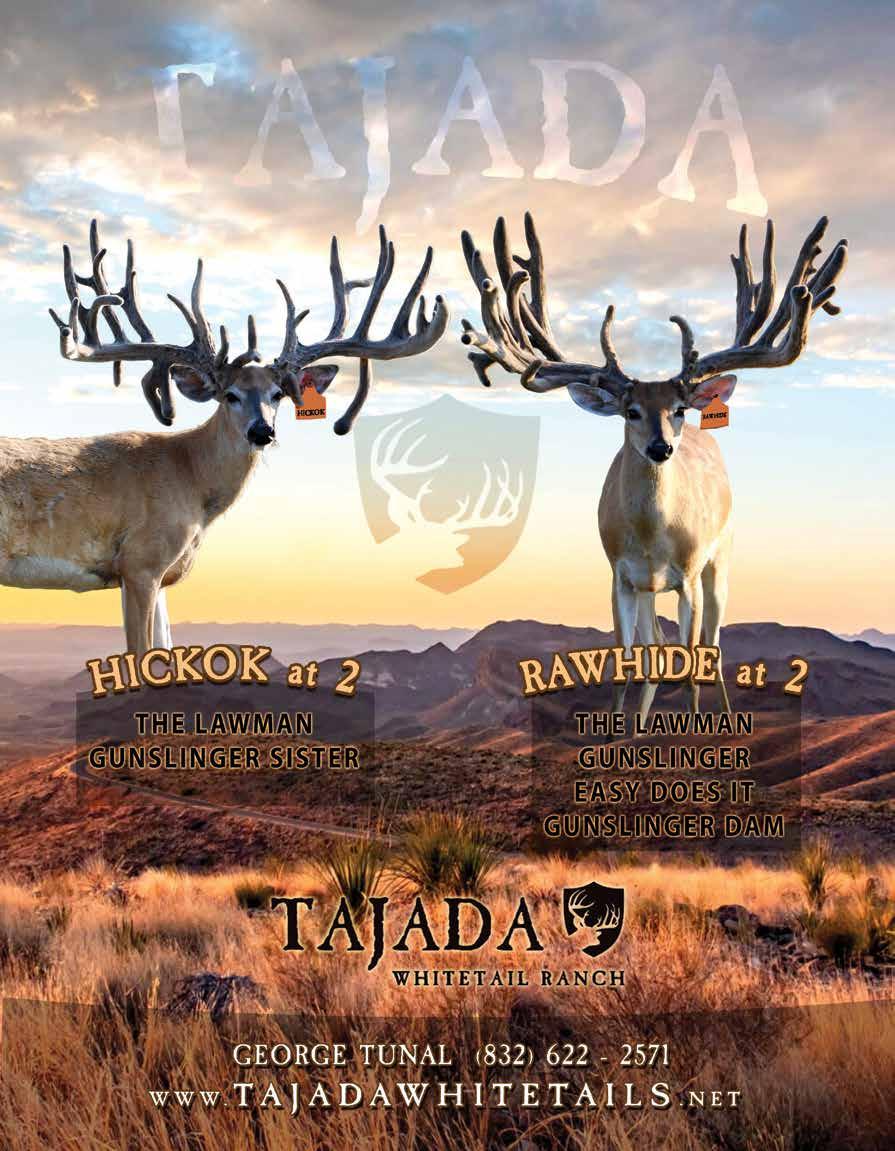
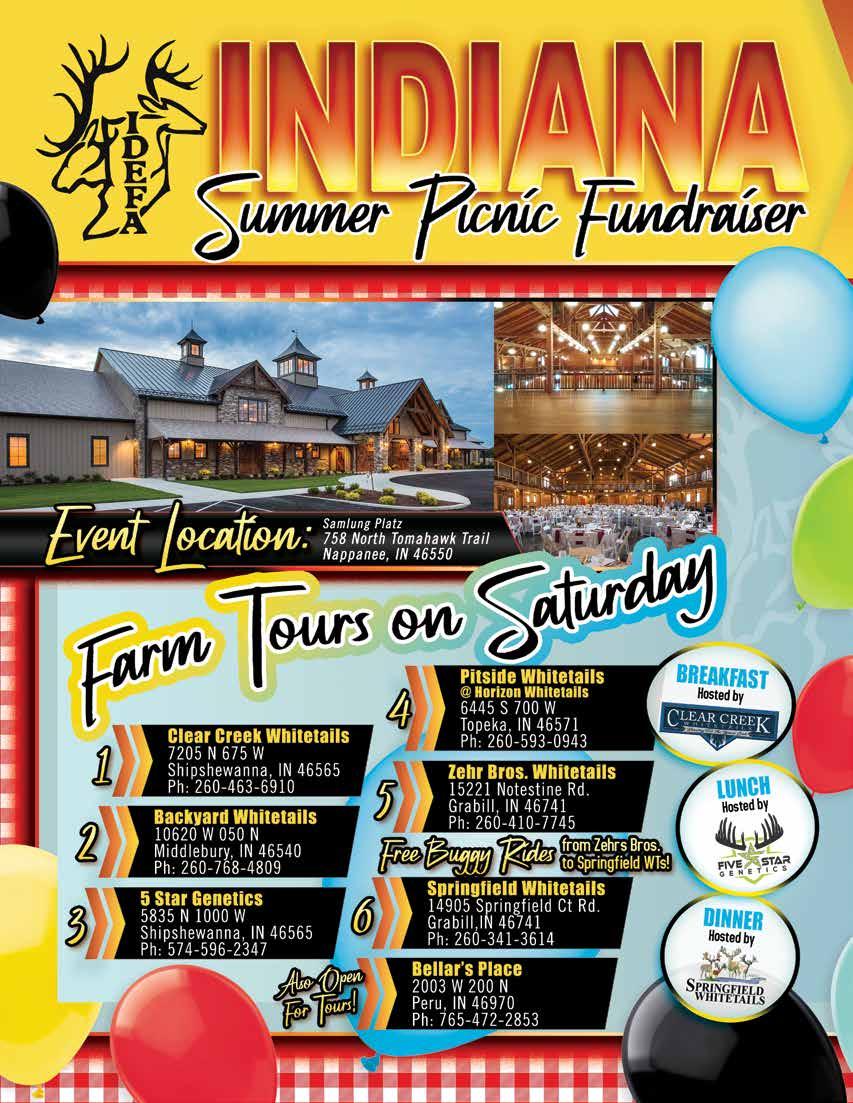


MK2™ KIT - PROPRIETARY FORMULA
The most widely used MK™ Kit on the market today. Contains a higher concentration of medetomidine and ketamine than the original MK™ formulation which provides the ability to use less medication and a smaller dart resulting in improved accuracy when capturing.

MKB™ KIT - PROPRIETARY



MKB2™ KIT - PROPRIETARY FORMULA
Contains higher concentrations of medetomidine, ketamine and butorphanol than the MKB™ Kit, which provides the ability to use less medication and a smaller dart, resulting in improved accuracy when capturing. It’s recommended for super exotics and large cervids that may be more difficult to sedate.

Developed by a zoo veterinarian to allow wildlife handlers to induce a reversible sedation, the MKB™ kit offers smooth induction with faster reversal times due to the lower concentration of ketamine. It’s recommended for sedation scenarios where the procedure being performed doesn’t require the animal to be on the ground for more than 15-20 minutes. Our MKBM™ Kit builds on our MKB™ combinations by adding midazolam to provide superior muscle relaxation and more reliable sedation. It’s recommended for the chemical immobilization of numerous large exotic hoofstock species including bongo, kudu, gazelle, eland as well as other African hoofstock and certain domestic wildlife species.

LEARN MORE
Disclaimer: The information contained in this advertisement is general in nature and is intended for use as an informational aid. It does not cover all possible uses, actions, precautions, side effects, or interactions of the medications shown, nor is the information intended as medical advice or for making an evaluation as to the risks and benefits of using a particular medication. You should consult with your veterinarian about diagnosis and treatment of any health problems. Information and statements have not been evaluated by the Food and Drug Administration (FDA), nor has the FDA approved the medications to diagnose, cure or prevent disease. Medications compounded by Mixlab are prepared at the direction of a veterinarian. Mixlab compounded veterinary preparations are not intended for use in food and food-producing animals. Mixlab does not recommend, endorse or make any representation about the efficacy, appropriateness or suitability of any specific dosing, products, procedures, treatments, services, opinions, veterinary care providers, or other information that may be contained in this advertisement. Mixlab is not responsible nor liable for any advice, course of treatment, diagnosis or any other information, services or products that you obtain through this advertisement.


The name of John Stoltzfus’s favorite buck, “All In,” might also be the best way to describe the level of commitment that he and his wife and steadfast life partner, Etta, have for the deer industry and for their deer farm. All In. “As long as I’m alive I will raise deer,” Stoltzfus said. “Etta is just as locked in as I am.” Both feel they have a lot to be grateful for at their 10-acre deer farm, Five Star Genetics, in Shipshewana,
By: Gail Veley
Indiana. After having just recently participated in Northern Top 30, they feel very satisfied with the way things turned out.
“When someone buys a deer from us, we like to put a guarantee on it,” Stoltzfus said. “We want them to be successful, too.” Stoltzfus feels the success of Five Star Genetics not only comes from acquiring the best genetics and having the most superior pedigrees
possible, but also in buying the mother’s and sisters of famous well-known bucks such as Horse Power, Money Talks and Unforgiven. “While breeding for CWD resistance is also very important, I feel name recognition is too,” he said. “Having a sister or a mother of a famous buck is very valuable. People easily recognize those names. When you invest in proven genetics that is the best advertisement for your farm that you can have.”

In terms of breeding plans, the main focus of Stoltzfus this year is squarely on All In, their own homegrown twoyear-old Major League son, a “pretty clean” typical buck with a 30” wide mainframe

including 30” beams and 16” G2’s. As Stoltzfus and Etta raise close to 50 fawns this year (their 12th fawning season) from the likes of All In, Sudden Express, Triple Crown, Back in Black and Horsepower, they are eager to see what their future holds.
“We bottle feed our fawns and even keep fawns in our bathroom and bedroom briefly during bottle feeding season,” Stoltzfus shared. “We feel it’s very important to get them started the right way with a combination of goats mill and whole milk, also known as ‘red cap’ milk. It’s all about feeding them properly, their management and herd health. You have to take care of them. It’s a
constant, daily check-in type of thing.”
Stoltzfus also feels the same way about attending deer industry events such as Southern Top 30, NADeFA and IDEFA events. “It’s a great way to market your farm and make great connections and stay checked in,” he said. “The market in Indiana is very strong. We feel very lucky to be a part of it.” Check out Five Star Genetics under John Stotlzfus on Facebook!!





Hope everyone is doing well, it was good to see everyone that could make it to Nadefa. Spring and summer is a busy yet exciting time to be a deer farmer, with all the new growth and the possibilities every day things keep changing.
Hopefully everyone was successful during fawn season and keeping tabs of antler growth so far this summer. Keeping schedules and doing maintenance is a must and keeps us super busy, but with good health, we are Thankful we can continue doing what we enjoy.



Wish everyone a Great summer and hope to see you at Idefa fundraiser or possible farm tour.
Nel
Hi there. As I sit down to write this, we are just getting ready for kick off on fawning season here at Clear Creek Whitetails, always an exciting time of the year for a deer farmer. This can also be a very stressful time if the proper steps are not taken before this time rolls around. I will try to share some things in this article that we are using on our farm that have worked well for us.

First of all, what we consider most important is to get your does on a vaccination program that works for your area. We are using a vaccine that was developed by Dr. Jay Schiteman and Newport Labs. We also vaccinate does and fawns with Bar-Vac CD & T, a commercial vaccine. We try to vaccinate our doe once in the fall and then 30-40 days prior to fawning. Fawns will get 2cc vitamin B-12 (3000 mcg), and head gear fawn paste at birth. Their first vaccine shot will be given 3 weeks before they are weaned then booster them at weaning.
We also consider soil health in all our pens a very important factor. We are on a fertilizer program with L&M Ag which has helped immensely. We try to keep all deer off of the fawning pens for approximately 2 months prior to fawning (the longer the better).
Some newer things that we are breeding for on our farm as the science continues to prove that it will be here to stay, CWD resistance. This will be only our second fawning season that we really selected for the numbers. I would highly recommend that any current, and new farmers coming in, look into this for the longevity of this industry. I strongly feel if we can breed for this resistance we can have CWD be almost a nonfactor, but remember we will need to have the deer in our pens be resistant to it for that to happen.
We wish everyone a successful fawning season and the Lords richest blessings as we go through another year.
Earl Hershberger




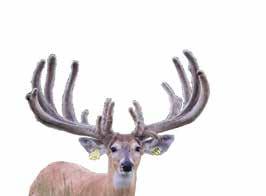










Are you Intersted in becoming a Board Member?
→ Do you love Indiana’s deer industry?
→ Are you Driven?
→ Do you work well with others?
→ Are you willing to participate?
→ Are you available for phone conferences?
→ Are you willing to be present at in person meetings (average 2 per year)?
If any of this describes you, please consider running for our Board of Directors. Please contact a current Board member or email us at








By: Gail Veley

Shock Effect has been taken over by Kathy and Travis Broadway, who are ready to fill orders and help deer farmers maximize the antler growth potential and body condition of their deer, among other things. Travis and Kathy, who also own and operate Winter Quarters Wildlife Ranch in Ethel, Missouri, are excited about the future of their company.
Shock Effect, a company originally founded close to 17 years ago, sells probiotic products formulated to help a deer, in all stages of life, maximize their potential. Featured products include Whitetail Conditioner, Buck Chill (to contribute to helping bucks stay calmer during the rut) Antler Maximizer (to aid in the growth of bigger, stronger and more impressive antlers) and Sea-Cal Calcium (to help maintain a sufficient level of calcium for a stronger skeletal structure while also preventing depletion of the skeletal structure.)
What originally began as a company started by Steve and Faye Thayer that sold only an antler enhancing product to local Missouri deer farmers, grew into a company that today sells a vast array of products along with a customer base that spreads from Mexico all the way to Canada. “Our customers appreciate the time and dedication it took to develop these products. Three things can determine the outcome of the health and vitality of your deer,” Travis explained. “Genetics, nutrition and stress. Shock Effect
products allow your deer to thrive and be the best they can possibly be in any and all circumstances.”
While other companies sell deer supplements “we know people depend on our products and want to continue buying them,” Kathy said. “When our previous co-owner decided to move onto something else, there was no question about stepping in to keep Shock Effect products available, because we have used them at our Missouri ranch for more than 11 years with great results.”
Every Shock Effect product is produced using no hormones, steroids or drugs and is also very specific to a deer’s nutritional needs and their very sensitive immune system. Every product sold today spent several years in a testing stage within a controlled herd, before ever being available to the public. “We know our customers believe in our products and that their herds respond favorably to them,” Travis said. “Our products were some of the first to really enhance antler growth. We have deer farmers telling us their two-year-olds look like three-year-olds.”
Through the years, Travis and Kathy have enjoyed seeing firsthand the favorable results and the extent to which their own herds of elk, red stag and whitetail thrive under Shock Effect products.
To order products or to apply for a sales position, please call Kathy at 318-446-2231, or send her an email at kbb720@gmail.com.












IF YOU HAVEN’T TRIED PNEU-DART’S RDD S , YOU’RE MISSING MORE THAN YOUR TARGET




By: Gail Veley • Sponsored by the Kentucky Alternative Livestock Association
When deer farmers tell Kevin Calmes “I know my deer,” he responds with “yes, but you don’t know the insides of your deer.” Calmes, who is a consultant and product shipper for Advanced Deer Genetics as well as the North American Small Ruminant Manager and Coordinator for Sexing Technologies, believes his specific recommendations for A.I. breeding and embryo flushing will provide a deer farmer with a safer and perhaps a more successful outcome.
Embryo flushing, often used to allow recipient does to carry the offspring of does with superior genetics, can be an efficient way to produce a uniformly high-quality herd. It all starts with placing CIDR’s in does with superior genetics, followed by follicle stimulating hormone (FSH) shots 11 days later and subsequently inducing multiple ovulations. In his years of experience travelling all over the world to work with cervids, Calmes has found that does, when run through a chute for any type of breeding procedure, tend to fight ovulation. “The stress put upon the doe by running them in a chute causes them to shut down in a sense,” Calmes, 57, explained. The better solution? “I prefer to run the deer into a facility, separated by ages, and blow dart FSH to get them to super ovulate,” he said.
Calmes has found that does who are darted with a specially designed 2.5 cc syringe with an 18 or 19gauge one inch needle shot out of a small pistol, absorb all of the FSH hormone and don’t even know they’ve been hit, since the small size of the needle and force of the pistol is so minimal. “The first time I’m in
there they might be nervous, but by the second or third time they aren’t because they don’t know something hit them,” he said, referring to the dart which was designed years ago by Chinese scientists. And while the hormone can also be administered in a chute with a pole injection, very often you will have backflow and wasted product, decreasing your chances of fertilization success.
After two to eight FSH hormone shots have been administered, depending on protocols, CIDRS’s are pulled on day 14 and followed up with a hormone shot of pregnant mare serum gonadotropin (PMSG.) The next step involves laparoscopic artificial insemination (A.I.) ideally performed 57-58 hours later. Approximately six to eight days after that, embryos are flushed (as though it were another laparoscopic surgery in terms of preparation) however they are under sedation longer. After flushing and retrieval, embryos are placed in a petri dish and graded on a scale of one to three by an embryo specialist. Grade one embryos, considered the better ones, are either placed immediately into recipient does or frozen for later use. Grade two and three embryos, considered not as hearty as grade one, need to be placed into recipient does immediately as they may not retain their viability should they be

frozen and used later. While a small percentage of does whose embryos are flushed may retain one or two and carry them to a full-term pregnancy “I suggest rebreeding her that same year naturally, to help break up the scar tissue from the previous procedures and not put any additional stress on her,” Calmes said. “We push these animals so much. And whether it’s the chemicals sprayed on what we feed them or a lack of chelated absorbable vitamins and minerals in their diets, I have also found in my work that our semen quality is driven down year after year. On average, ten years ago we had 4-6 billion cells per buck per collection, and today it’s 2 to 3 billion cells per collection. Given that deer genetics are held in such high regard, I believe the industry as a whole needs to sit down and look at this.”
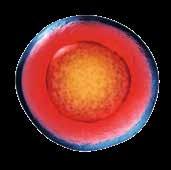






























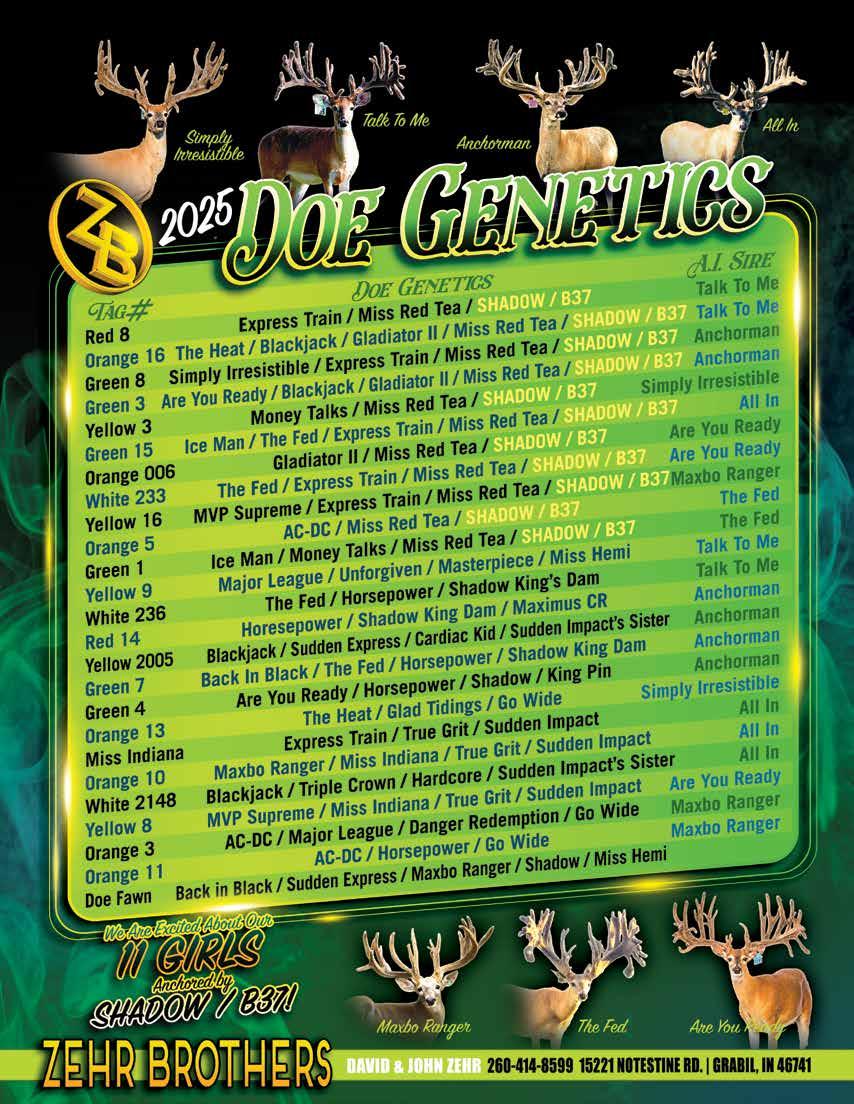










































































If you would like your farm or business featured on our business card pages, email digital pdf file or scanned image (must be readable resolution) of your business card to the email address below.
This gives IDEFA members a way to reach out to one another for services and to buy or sell deer! There will be limited pages for these card spreads, first come first serve. The overflow would be placed in the next issue and cards will be rotated each quarter.
Email to:
Erica Bratton indianadeer@gmail.com





By: Gail Veley • Sponsored by The Pennsylvania Deer Farmers Association
Early on in the start of each new year, Amy Stefanowicz takes inventory of everything she’ll need for the upcoming spring. Fawning season and the expectation of 54 fawns might be a few months away, but then again, it’s as though it’s right around the corner. Bottles, nipples. Check. Fawn paste, probiotics, goat’s milk, puppy training pads, cleaning supplies. Check, check, check. Known for her expertise in successfully raising calm and well-acclimated deer, Amy and her husband Jason of Awesome Whitetails in Middlebury, Pennsylvania may have the science of raising fawns perfected as this year marks their fifth season. In addition to meticulously managing a fawn’s health and immune system, Amy believes acclimating them to outside stimulus is just as important. Given that deer generally become comfortable with specific individuals, she plays a radio 24/7 inside the barn to get them used to strange noises and voices. “I’ve found this really helps them to not overreact if someone new comes around,” Amy said.

However, the most pressing initial issue is a fawn’s intake of colostrum within 12 hours of birth. Good, diligent mamas and babies that latch on pave the way for the next steps Amy takes. After each doe fawn (and struggling buck fawn) intakes sufficient colostrum, they are pulled and moved into a fawn facility where they spend up to three weeks isolated inside a 2 x 3 feet durable polymer box complete with drainable rubber (piglet) flooring, allowing urine and droppings to fall into a black tray beneath the flooring, covered by a puppy pad. Unlike wood that may allow germs to soak in and remain active and risky, Amy knows plastic does not do that and is much easier to clean. This can ensure a healthier fawn, one that will be introduced to other healthy fawns.


Sometimes fawns may need more intensive care and if so, may spend time in a bedroom or dog crate inside the house, until they are strong and healthy enough to be in the official fawn barn. Building up their strength and immunities also involves the careful administration of vaccines, so as to not puncture their fragile skin. Next, ear tags are attached and microchips inserted. Inside each 2 x 3 fawn box Amy also places a small bowl of natural dirt to softly and safely introduce them to their eventual life outside in the deer pens, which usually occurs after week three. “Unless you have a jumper,” Amy, 46, explained. “They might need to go outside sooner.”
Amy’s bottle-feeding regimen includes a combination of goat’s milk and red cap milk, given at 6 a.m., 2 p.m. and 9 p.m. for four weeks, followed by two feedings from week five until week nine, when henceforth bottles are offered merely once a day. After 13 weeks, fawns fully transition to solid food and water. Through this micro-management system, Amy has gained a reputation as being somewhat of an expert on the process of raising healthy, calm and well-acclimated deer. Her advice has even been sought out by numerous others in the industry.
“Jason and I just firmly believe in our process,” Amy said. “We feel it’s worth it in the long run and have found our deer are more ready to face whatever may come as they grow into healthy mature adults.”













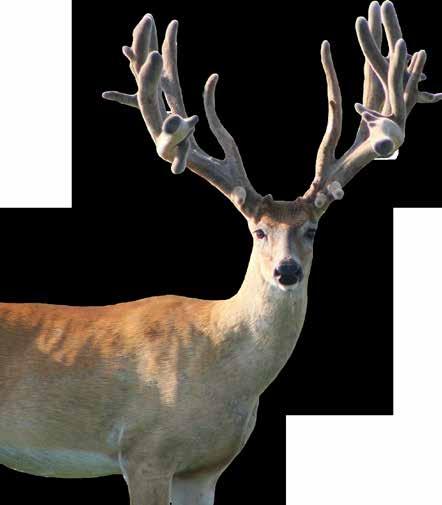





The coming of spring calls for a walk, and when green shoots or mushrooms emerge, I start feeling inspired to forage. It starts with halved radishes and spring mushrooms, roast cut-side down in butter & miso. They’re savory, but slightly-sweet and balance the peppery bitterness of freshly foraged spring greens dressed in a tangy yogurt-tahini sauce. Just add a perfectly seared loin of venison and you’ve got a spring meal fit for royalty, but available to all.
• 2 pound venison loin
• 2 pounds radishes with their greens, root ends of radishes trimmed, radishes halved lengthwise
• 8 cups greens reserved
• 1/4 cup white miso paste
• 1/4 cup plain yogurt
• 1/4 cup tahini
• 3 tablespoons unsalted butter, melted
• 1-1/2 teaspoons honey
• 1 teaspoon grated lemon zest plus juice
• 1 garlic clove, minced
• Olive oil
• Salt and pepper


1. At least 30 minutes and up to 2 hours before cooking, take a whole venison loin out of the refrigerator and salt liberally.
2. Heat a well-oiled cast-iron skillet to smoking. Pat your loin dry, pepper and place in your pan until wellbrowned on all sides. When internal temp reaches 120, remove, tent with foil and allow to rest.
3. Toss halved radishes with melted butter; miso, honey; and a pinch of salt. Arrange radishes cut-side-down on a sheet-pan and roast in a 500 degree oven ‘till tender and and caramelized, about 15 minutes.
4. Whisk yogurt, tahini, lemon zest and 1 tablespoon juice, garlic, salt and pepper to taste.
5. Reserve 3/4 of this mixture for plating, with the remaining, add 2 tbsp Olive Oil and 2 tbsp lemon juice and 2 tbsp water & whisk.
6. To plate: Schmear the yogurt-tahini sauce across your plate. Dress greens, cover with radishes & mushrooms. Slice venison loin in 1/2 inch medallions and arrange across the salad. Enjoy!



SCIENTIFICALLY FORMULATED NATURAL SUPPLEMENT TO HELP GROW LARGE, HEALTHY DEER AND BIG ANTLERS!
Nutrient rich formula contains highly bioavailable ingredients, including our proprietary calcium/phosphorous complex with Antler D TM, that are required to support body and bone growth, especially for fast growing bucks
Contains probiotics and targeted enzymes to support gut health and proper digestion

Available in pellet or powder that can be top dressed or mixed in feed. Great for antler growing season and young bucks, too
PRECISELY FORMULATED TO HELP MAINTAIN A NORMAL AND RELAXED DISPOSITION IN ALL CERVIDS
Provides optimal levels of magnesium, Vitamin B1 and inositol to promote calmness and provide help for restless animals
Contains no herbals, tryptophan or chemicals, eliminating concerns of unwanted side effects
Use PeaceMaker to “keep the peace” during pre-rut, rut, transportation, weaning and anytime destructive behavior may occur
POWERFUL SOLUTION FOR HEALTH & PRODUCTIVITY
Helps maintain digestive health and productivity
Contains micro-encapsulated probiotics, targeted enzymes and a novel fiber complex
Use in does before fawning, during lactation and all cervids during times of environmental stress

HELPS PRODUCE HEALTHY, FAST GROWING FAWNS
Helps maintain normal digestive health
Supports a healthy immune system
Feed powder for 14 days to bottle fed fawns
Paste is ideal for fawns left on does

& DEER XTR™
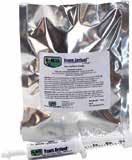
ROBUST FAST RESPONSE FOR FAWNS & OLDER DEER
Innovative formula delivers max digestive support, especially in newborns
Rapidly delivers help for GI health and a functioning immune system
May also be used post-tranquilization to support healthy recovery










By: Gail Veley • Sponsored by The Indiana Deer and Elk Farmers Association

Aprofessional deer hauler hopes for a few very important scenarios when they pull their rig into a farm. This includes adequate room to get the truck and trailer turned around and aligned or situated safely in the loading area, along with dry ground conducive for the occasion. “Everyone gets a little nervous when you’re loading deer,” said Delvy Workman of Deer Works, a professional deer hauling company out of Ashland, Ohio. “A lot of people don’t think about loading or unloading deer when they set their place up. This is a really crucial thing to figure out.” Having hauled deer for 14 years, Workman hopes for the most efficient process possible.
Ensuring a safer loading experience begins first with allowing your deer to walk into and through your handling facility on a regular basis, said Dave Schwartz of Shallow Pond Whitetails in Shipshewana, Indiana. “Once we wean our fawns, we move them into a corral pen that’s attached to the handling facility and utilize that to get them used to it,” he said. “That way we can get them into there in a short amount of time when we need to.” By also working deer at random times and moving them into dark
‘pre-loading’ rooms, it can eliminate or greatly reduce the amount of stress put upon deer. “We can sell a doe and within five minutes live load her onto a trailer,” said Schwartz, who prefers to load deer into trailers specifically designed for deer (not a makeshift horse trailer) and to use a reputable, reliable hauler. “There are good deer haulers out there with specialized cargo trailers with great air flow and air conditioning and adequate room for bucks or does,” Schwartz emphasized. “Trailers set up for deer hauling are way better and are going to minimize the stress from the entire moving process. It’s important to keep the stress as low as possible. If you are sedating and loading bucks, make sure they are up and on their feet before moving the trailer.”
Verlin Yoder, a veteran of the deer industry since 1999 and owner of Clay Kuntry Whitetails in Millersburg, Indiana, remembers the days when deer farmers used 2 x 4-foot individualized wooden boxes for hauling deer. This often involved a ‘deer rodeo’ in an effort to get them sedated with telazol and/or rompun, and then inside the box. “It might take four guys. Sometimes you’d have to wrestle the deer down for
sedation,” Yoder recalled. “You’d reverse them inside the box and then they’d jump around inside of it. And we always seemed to have some sort of surprise.” A great sense of relief overcame Yoder when he was able to attain his own handling facility and loading chute in 2006. “It’s one of the best investments a deer farmer can make,” he said. “You need to haul deer for all sorts of reasons. Breeding season. Hunting season. Sales. Boarding.” Boarding does for the sake of breeding requires careful timing, as you don’t want to bring them back too soon or too late in their pregnancy, for fear or losing the offspring due to hauling stress.
Depending on the distance, longer hauling trips, such as up to eight to 10 hours, may require the hauler to put straw bedding down for comfort and to also include hay and water. And last but not least, the most important advice might be “give yourself plenty of time,” Yoder said. “Haul at night when it’s cool and the deer are naturally calmer. Keep the trailer dark and peaceful and wellventilated. You are hauling some very precious cargo and want everyone to arrive safely.”

“You need to haul deer for all sorts of reasons. Breeding season. Hunting season. Sales. Boarding.”





By: Gail Veley • Sponsored by the Kansas Alternative Livestock Association
Early, non-symptomatic detection of CWD in a whitetail herd could become as simple as drawing blood, thanks to a revolutionary diagnostic test currently being developed by Dream Genomics. Based out of Northbrook Illinois, Dream Genomics is a newly developed visionary biotech firm started in 2023, whose energy and efforts are fully invested in the “Discovery Phase” of developing a reliable, ultimately fool-proof and scientifically recognized CWD detection blood test. Leading the charge for Dream Genomics is Dr. Gary Pusateri, CEO and Founder, Michael Falduto, Chief Technology Officer and Founder as well as Dr. Scott Magnuson, Chief Scientific Officer and Founder.
Along with developing a reliable test, are the challenges of buying equipment to continue the research along with obtaining adequate

numbers of positive CWD samples. Dream Genomics is actively searching for sponsors and donors in the form of corporations, deer associations and private individuals to continue on this quest.
NADeFA and The Cervid Livestock Foundation (CLF) have donated substantial seed money to Dream Genomics, in an effort to keep the research ball rolling and to help purchase testing plates or “chips” as they are commonly called.
Chips, an array that looks at all the genes in a deer’s genome and measures the gene expression via profiling using RNA, fully measures a deer’s response which creates a “bio-profile” for early detection. This technology could perhaps also be used to “stage” the disease in the fact that it will be specifically used at the front end of detection, and not the back end.
Unlike old traditional testing methods which examine CWD prions in already infected organs, this new test is being designed to preemptively find CWD in a singularly fashion, before symptoms develop and before others in a herd are also affected. “Their progress is amazing,” said NADeFA President Shawn Schafer. “This could completely change everything in the industry as we know it right now. Gone may be the days of five-year quarantines or repeatedly extracted rectal samples.”
Resounding in the deer industry is the common goal to eradicate CWD and to develop a minimally invasive diagnostic test, explained Dr. Pusateri. “Once adequate project funding has been established and

enough positive samples have been acquired, Dream Genomics can move towards biological confirmation that our test is accurate,” he said. “We strongly believe that we can reach our goal of making this real and attainable.” Anyone interested in donating towards Dream Genomics research, please contact Dr. Pusateri at his office at 847-291-9602 or his cell phone at 715-891-7878 or email him at gpusateri@dreamgx.com. You can also check out the website at www.dreamgx.com.















Scan QR Code to View the Magazine!

All advertisers that are published in our 2025 state associations magazines will have the opportunity to place a single Buck update photo in this September Showcase Book.
Reservation for space and buck info will be due no later than August 12th, 2025. If you have an existing picture ready to go, that will also be due at that time. If you would like to send in a last minute photo of your buck, the cutoff date is September 1st by 8am CST. Placement will be in order of first come first serve. Printing and mailing will start September 4th and be in hand between September 16th-20th. Just in time for semen sales getting ready for Breeding Season. These will be mailed to Breeders and Ranch members of the 18 state associations we service.
(More information will be mailed out to all current advertisers closer to the date)
Cost: $180.00 each 1/4 page ad or 4 for $700.00 (Pre-register and we will contact you for further information) PRIME SPOTS WILL BE AUCTIONED - LOOK FOR DATES TO BE POSTED ON OUR WEBSITE

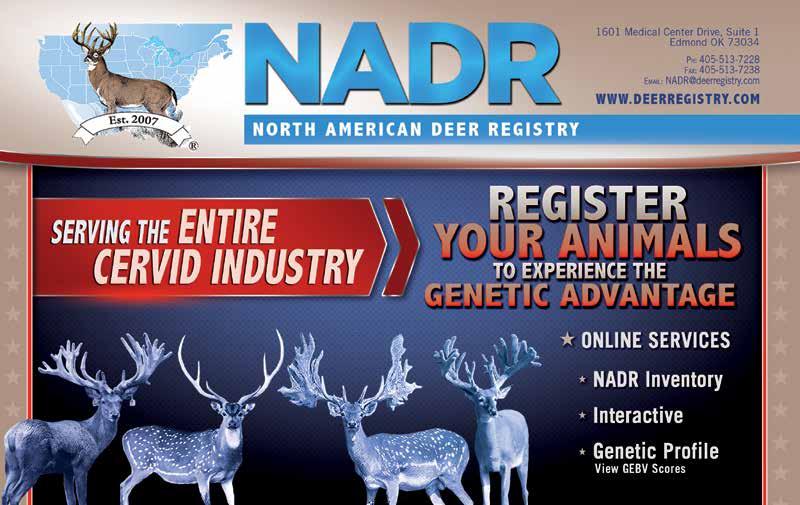





• All-Milk Protein from Premium Food-Grade Milk Ingredients
• Essential Vitamins and Complex Minerals
• Balanced Fatty Acids
• Improves Digestion
• Promotes Growth and Performance
• Fawns up to 1 week of age: Feed 16 oz. of formula daily, divided into 4 – 6 feeding.
• Fawns 1 week to 1 month of age: Feed 24 to 30 oz. of formula daily, divided into 4 feedings.
• Fawns 1 month to 2 months of age: Feed 30 to 35 oz. of formula daily, divided into 2 to 3 feedings.
• Fawns 2 months to weaning: Gradually decrease formula and number of feedings to approximately 15 oz. of formula once daily until fawn is fully weaned at 12 to 14 weeks of age. Provide a weaning diet and fresh clean water to the fawn.
For oral use only. These feeding directions are guidelines. As each animal is an individual, the feeding rate may be increased or decreased according to the needs of the neonate.
Feeding directions for other species can be found on our website.

• No Refrigeration Needed
• Easily Palatable
• 18 Month Shelf Life
• Available in 20# & 8# pails
• 24/7 Technical Advice & Support
• Formula for other Exotics and Wildlife Available



The rules for sudoku are simple:
A 9x9 square must be filled in with numbers from 1-9 with no repeated numbers in each line, horizontally or vertically.
To challenge you more, there are 3x3 squares marked out in the grid, and each of these squares can’t have any repeat numbers either.
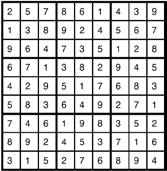

Thunderstorm
Sunscreen
Fishing
Beach
Breezy
Backpacking
Mountains
Bonfire
Muggy

Last Issues Puzzle ~ Answer Keys ~
Adventure


Last Issues Puzzle ~ Answer Keys ~








Ever built a fence to keep critters in, or critters out? Chances are, you’ve run into a dilemma that spans back to the dawn of fence building tradition The underappreciated artform of attaching wire or panel to a post. In a rocky, muddy, sloped field with only-kindacrooked-posts, it comes down to grit and sheer determination to beat a staple into submission, without pounding a finger too!
After 60 some odd years of ranching in Montana, and subsequently responsible for over 100 miles of fence, Curt Almy became increasingly disgusted with the “old fashioned” ever-rusty fence staple In 2016, Following a particularly rough day on a nasty section of fence, Curt received a bit of divine inspiration that prompted him to retreat back to the old workshop, to tinker with this new idea He declared the new product would be the antithesis of the old fashioned staples, the new claws would be simple to use, require only an impact driver instead of tangled air tools or hammers, be rust resistant, be reusable, and most importantly the new claws would be vastly stronger than the old fashioned staples



Gone would be the days of staples p out and getting stuck in a hoof or a t financial advisor by day since the 80 rancher by evening, it took Curt mon dedicated weekends to create the ul “redesigned mousetrap” of the fenci Who would know that such a simple could be so complicated?
Several iterations of what would b the “Cat’s Claw fence claw” were ma tested by local fencers. By 2018 a rus resistant, patented version of the Cat Fastener w d f k t and i 2019 the as released


Testin s and receiving th y the first steps among many, in order to successfully launch the business. Chiefly, and rather importantly, an official name was needed for the product! During deliberations with his wife Patricia, it was determined that t historic Crown W 1914 George Ranc be used as the official headquarters





With the location d more amusing to the pa cats dominated the ran entertained the idea of area where the ranch w suggested that the prod they came up with “Ca
In 2018, the first $5 allowing the operation plague looming in the n play a major role in a d Canadian companies w bring attention to the fir posts made by Full Circ that Cat’s Claw could h gone through one of th

As video production time in 2020 approached, many warnings were issued, and borders closed a day after the Cat’s Claw crew made it home. The markets were turbulent, and the future of Cat’s Claw was also in question Would a small Mom & Pop operation make it through such a worldwide disruption?

1/4 magnetic hex driver is included in ever y bottle

Softwood claws 2” screw stays secure even in a rotten post
p j , g g j y to the Cat’s Claw crew If you have ever used a Cat’s Claw Fastener, the crew would love to hear from you! You can reach out at info .com, or write to:
Surprisingly, the answer was emphatically, “yes.” While many businesses saw stagnation, the topic of modern homesteading became increasingly popular. Seeing an opportunity, (Daughter) Toby-Jeanne began advertising to homesteaders and buffalo fencing operations, which in turn lead to connections within Zoos and even the Cervid community.



Cat’s Claw Fasteners 28 N. Montana Miles City, M T 59301
Who knows, your story could be featured next!
Curious to try them for yourself? Head on over to www.catsclawfasteners.com and enter code: CERVID2025 for free shipping until August 31st, or give them a call at 406 851 CLAW(2529)



Date: _____________ Membership year is January 1 to December 31
Name:__________________________________________________________________ (first) (last) (Middle)
Spouse:_________________________________________________________________ (first) (last) (Middle)
Farm or Ranch Name:______________________
Address:________________________________________________________________
City:__________________________ State:______ Zip:___________County__________
Do you currently own Cervidae in the state of Indiana?
Membership Categories __________
$ 75 Full Membership plus Spouse with Voting Rights __________ $ 50 Full Membership with Voting Rights __________ $ 50 Supporting Membership without Voting Rights
CREDIT CARD INFORMATION FORM
CREDIT CARD NUMBER:
CARDHOLDER NAME (as shown on card):
EXPIRATION DATE (mm/yy): CVC: ZIP
ONE TIME CHARGE: RECURRING ANNUAL CHARGE:
I authorize IDEFA to charge my credit card above for agreed upon Association Membership purchase(s). I understand that if I choose recurring annual charge my information will be saved to file for future transactions on my account. I may cancel this authorization at any time by contacting IDEFA. Recurring Membership charges will take place on or around January 1st of each year. I further understand it is my responsibility to report any changes in my contact information so that there is no interruption in communications.
AUTHORIZED SIGNATURE:
Return Form and payment to:
Bratton 1050 N 600 W LaGrange, IN 46761
Email: IndianaDeer@gmail.com
44 ISSUES FOR 1 YR.
Reaching out to over 2500 members (11 Publications x 4 quarters) 17 State Associations - Approx. 2500 readers
$189 / Issue ($8316. / Yr) ~ Full Page

$107 / Issue ($4708. / Yr.) ~ Half Page (55-59% Discount off single ad placement) Doe-Re-Mi
16 ISSUES FOR 1 YR.
(4 Publications of your choice x 4 quarters)
$220 / Issue ($3520. / Yr) ~ Full Page
$121 / Issue ($1936. / Yr.) ~ Half Page (48-54%


4 ISSUES FOR 1 YR.
(1 Publication x 4 quarters)
$252/ Issue ($1008. / Yr) ~ Full Page
$137 / Issue ($548. / Yr.) ~ Half Page (40-48% Discount off single ad placement)










Indiana Animal Disease Diagnostic Laboratories
ADDL at Purdue University HEEKE ADDL - SIPAC 406 S University St 11367 E Purdue Farm Road West Lafayette, IN 47907-2065 Dubois, IN 47527-9666 P: 765-494-7440 F: 765-494-9181 P: 812-678-3401 F: 812-678-3412
VETERINARIAN:
Name
Indiana License #
Dr. Jeff Pyle 24004598
Clinic Address
City, State, ZIP
Phone Fax
Results: Fax Email
Manchester Veterinary Clinic 11798 North State Road 13 North Manchester, IN 46962 (260) 982-6673 (260) 982-8200 jbpyle@fcremc.coop
Additional Results by:
Email Fax
springfieldwts@gmail.com (260)768-9182
OWNER:
Name Address
City, State, ZIP

ANIMAL:
Site/Farm/Unit
Address
City, State, ZIP
Site/Farm/Unit Phone
Premise ID
SIGNATURE FOR REGULATORY SUBMISSION:
Veterinarian
Bill to Veterinarian Bill to Owner (Phone) Purdue Fund Bill to Third Party (Name/Phone) RIO/SIO
HISTORY: Clinical Problem: Respiratory Enteric Neurologic Reproductive Other
Age _____ day wk mo yr # On Site _____ # In Affected Group _____ # Sick _____ # Dead _____ Breed ____________
Whitetail Deer
Animal ID Weight ____________ Date & Time of Death _______________________________
Cause of Death: Natural / Euthanasia - If euthanized, method used: ______________________
Were barbiturates used? Yes / No - If chemical euthanasia, chemical(s) used: ________________
I certify that the animal has not been exposed to a level of chlorinated pesticides or PCBs in excess of regulatory limits for animals. As the responsible party, I certify that the above information is accurate and true.
Signature and Date: ___________________________________________
***Testing is approved for Mycoplasma spp. PCR on any respiratory case. If identified, lung tissue is to be forwarded to Newport Labs with the IDEFA Newport submission form on file. ***CWD samples will be collected and tested on all cervidae greater than one (1) year of age.*** Please perform culture and sensitivity on tissue samples submitted or tissues that are visibly diseased at time of necropsy. Also perform parasitology testing.
ATTENTION IDEFA MEMBER: Once results are released to above destinations you will be entitled to your reimbursement from IDEFA
Species:
Aquatic
Avian
Bovine
Camelid
Canine
Caprine
Cervid
Equine
Feline
Ovine
Porcine
Other
Sex:
Male
Female
Male - Neutered
Female - Spayed
Cremation:
Pets Remembered (ADDL-WL Only)
Pet Rest
Individual Cremation
Group Cremation
Ashes Returned To:
ADDL/HEEKE
Owner
Vet Clinic
Differential Diagnosis or Disease(s) Suspected _________________________________________________________________________________________
Legal/Insurance
Suspect (County) _______________________________________
Standard Necropsy Abortion Protocol
animal or any agent acting with the express authorityof the owner agrees that the specimens have been submitted to ADDL and will be handled by ADDL in accordance with ADDL testing procedures, policies, and fees. This handling will include all specified testing and safe disposal of the animal’s remains. Specimens and
federal animal health officials, or 3) when a Foreign Animal Disease is suspected. This form only lists frequently requested tests. For the complete list of tests, consult the ADDL Fee Schedule.
Client of Cremation Service? Yes
No

